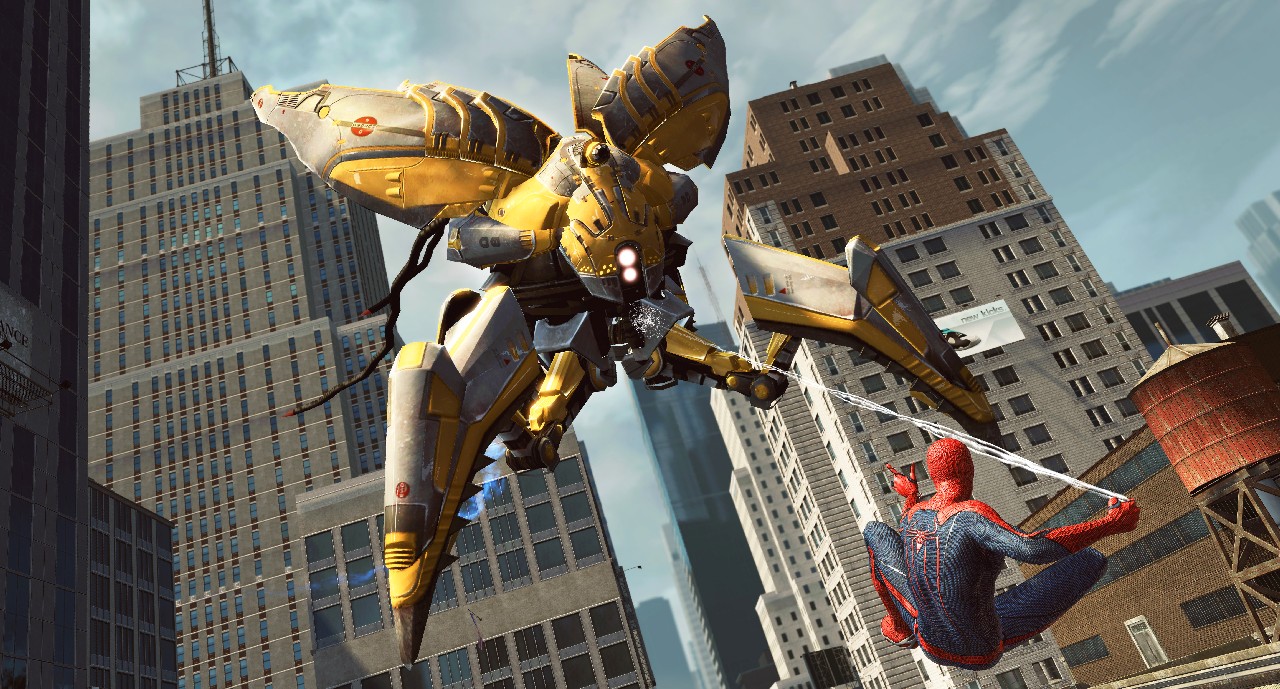
Play the game based on the movie based on the comics that were turned into a movie just a decade ago.
Late in Activision’s Amazing Spider-Man game, our titular arachnid hero is crawling through a wide industrial-grade vent when he stops to question his actions.
“What am I doing with my life? I should be studying, flirting with cheerleaders and playing WoW,” he says. “Instead I’m about to get killed in a robot factory.”
Oh, Pete. You’re right. You may have mechanical webshooters and possess genetically-altered DNA that’s given you superpowers, but deep down, you’re still just a teenager.
Spider-Man—or more appropriately his nerdy alter ego Peter Parker—has historically been considered one of the most relatable heroes. Canon has by and large depicted Pete as an actual person with real life problems, to the point where Steve Ditko wouldn’t necessarily draw him in-costume for more than a few panels in some early issues. Trading adolescent social anxiety and encounters with bullies for responsibility that comes with personal loss (and subsequent heroism) is a story we can all relate to, even if Peter is both superhuman and, conversely, in high school.
Yet there are worse monsters than supervillains at that age, the biggest perhaps being the quest to find one’s identity. Beenox’s Amazing is a bit of an unruly teen; if the metric of all superhero games is to make you feel like the source material’s protagonist, wise-cracking, freewheeling Spidey is probably among the highest in demand. The problem is, ol’ webhead can’t figure out who he really wants to be.
Technically Amazing is a film-tie in, at least using Spidey’s film costume and sporting an aesthetic that seems like it’s in line with the general visual style of Marc Webb’s reboot. This is one of the weirdest aspects of the game. For whatever reason, no one bothered to go through the legal rigmarole to use the digital likenesses of Andrew Garfield and company, despite Spider-Man and the Lizard looking just like their cinematic counterparts.
But the events of the game take place after the film, in an original story. It creates a nonsensical franchise paradox where, picking up on a narrative extrapolated completely from the reboot’s script, a handful of classic Spider-Man villains are introduced as though they’re part of that universe—essentially repurposed through its interpretation of Oscorp.
These identity-less, nearly lineless “fake” movie villains aren’t really who they’re actually supposed to be in the comics, either, adding nothing to the plot or general interest (with the exception of fake movie Alistair Smythe, played with goofily increasing mania by Nolan North). They’re basically so much web fluid fodder, offering a few more one-off tussles to help undulate the pacing. So my question is this: with lookalikes rendered on-screen, sound-alikes in the booth and a plot that has nothing to do with the film (and could have easily been written as a standalone story), why is Beenox’s Amazing a tie-in at all?

Narrative and art direction aside, Pete seems to be a little mixed up over how he should act, too. When he is swinging in “open-world” Manhattan (a term I use loosely in a design sense), the wall-crawler feels authentically spectacular. While not quite offering quite the animation nuance of, say, Nathan Spencer’s swing in the ill-fated Bionic Commando reboot a few years back, flying through the air with acrobatic ease is a lot of fun.
Several times I caught myself web-swinging among the skyscrapers just to see how high I could go, or to collect the myriad comic pages scattered around the city, or just to see how much I control I had in varying Spidey’s movements while thwipping around the skyline.
That said, the minimal interactions involved in extra missions means this Amazing isn’t truly open world. Its reasonably detailed overworld map isn’t bad, considering how much of the game’s design resources are eaten up by the linear, scripted levels that make up the core of the gameplay. It’s also a nice tidbit to give fans; Spidey needed to stretch his legs after Beenox’s last two interior-oriented games.
Where Pete seems most confused is in actual combat. Standard melee is a slick, streamlined affair where you effortlessly rough up several baddies at once, activating your spider-sense to stylishly evade attacks with well-timed inputs. You can also web out of trouble, retreating to a nearby wall or ceiling to survey your opponents below, and jump back just as quickly into the fray with your grappling-esque web rush ability.
You’re basically playing Arkham Arachnid (you can also wall and ceiling crawl just about everywhere if you prefer stealth webbing), only applying Rocksteady’s template to smartass Peter Parker isn’t necessarily effective or appropriate. This isn’t fanboy nitpicking, as much as it may sound like it—Beenox’s attempt to emulate Batman isn’t as smooth or well-implemented as the Arkham games’ original design, and by its nature more or less forces you to jump in and out of combat, which makes for awkward pacing.
Spidey’s array of upgradable moves is also unfortunately somewhat unbalanced, with a few overpowering abilities and puzzlingly weak webbing. When you get into a groove it’s still pretty entertaining, if a bit simple, to take care of a cadre of thugs, though it becomes much less so when acid-spitting monsters and shielded robots become the norm.
By far the most enjoyment you’ll have with Amazing lies in the underused high-speed aerial boss battles versus Smythe’s nimble spider slayer robots. These fights make up for their relative lack of challenge with wonderful cinematic scale and velocity, highlighting the thrill of webswinging for your life with all manner of lasers and high tech weaponry blasting after you across the sky. Although too brief, the sequences are so enjoyable they make hand-to-hand boss battles relatively tepid by comparison.
It’s been obvious for a few years now that Beenox loves Spider-Man, and not just because Activision gave them the keys to the franchise. Keeping to their one game a year policy, though, I think Amazing was given a shorter shrift being a tie-in.
This feels like a game undermined by the rigid schedule demands of having to release alongside a film. And while I feel it’s almost a travesty that a first-person Mirror’s Edge-esque Spider-Man game hasn’t yet been attempted (especially given Webb’s original teaser trailer), Amazing is one of Beenox’s most enjoyable Spidey adventures to date—when it works. With more development time and greater freedom to draw from the comics, Pete might not have had such a hard time grappling with who he needed to be.
The Amazing Spider-Man was developed by Beenox and published by Activision. Our review is based on the Xbox 360 verison. It is also available for the PlayStation 3, PC and Wii.
Steve Haske is a Portland, OR-based gun-for-hire journalist whose work can be found in Eurogamer, Electronic Gaming Monthly, Edge Magazine and CityArtsNYC, among other places you might have heard of. When not actively writing he also regularly co-hosts the A Jumps B Shoots podcast and can be tweeted @afraidtomerge.